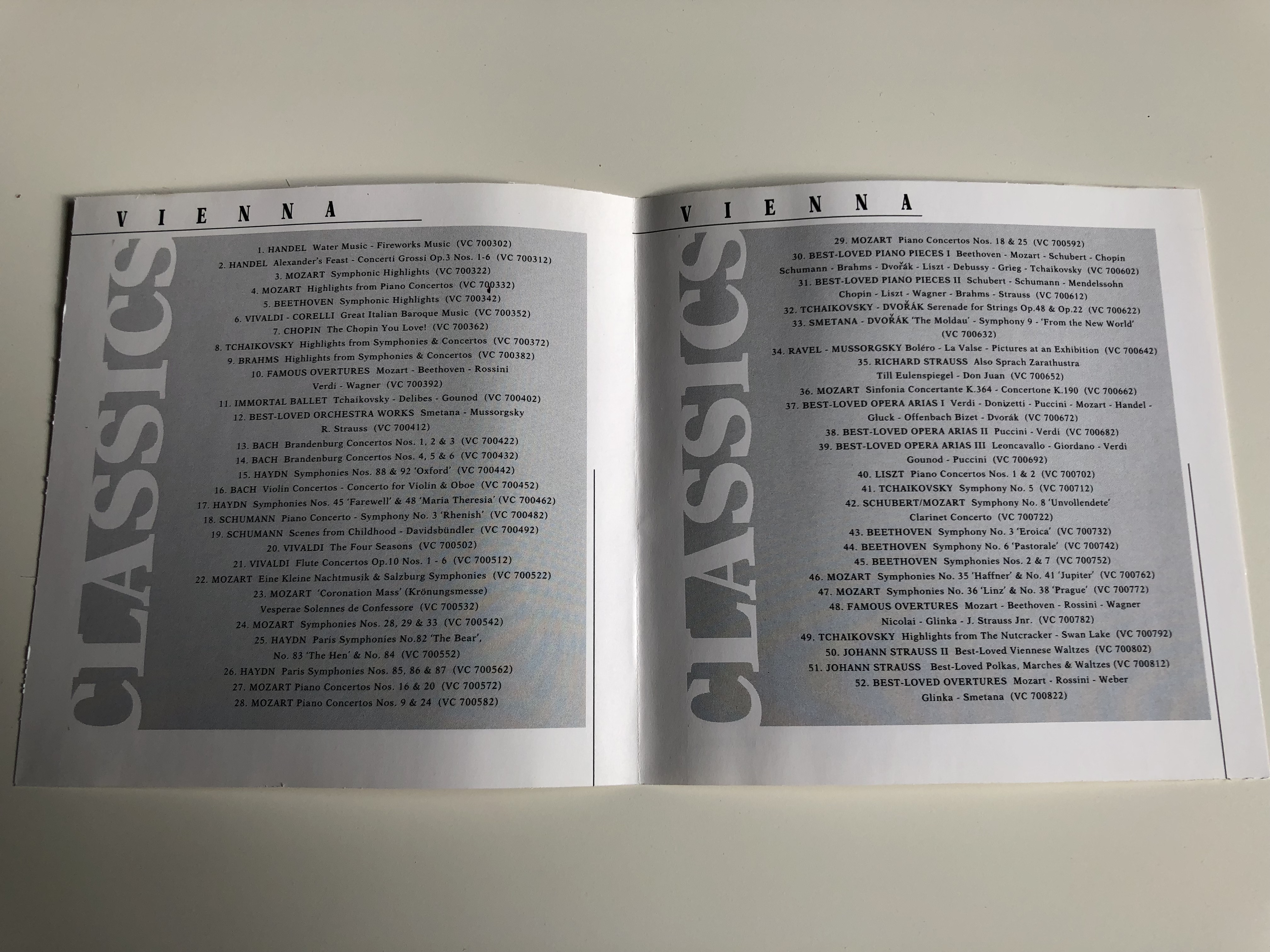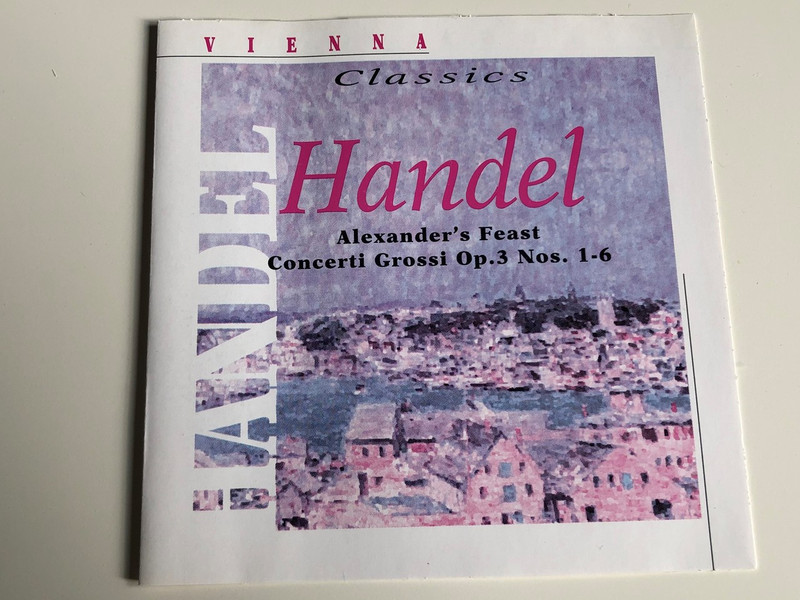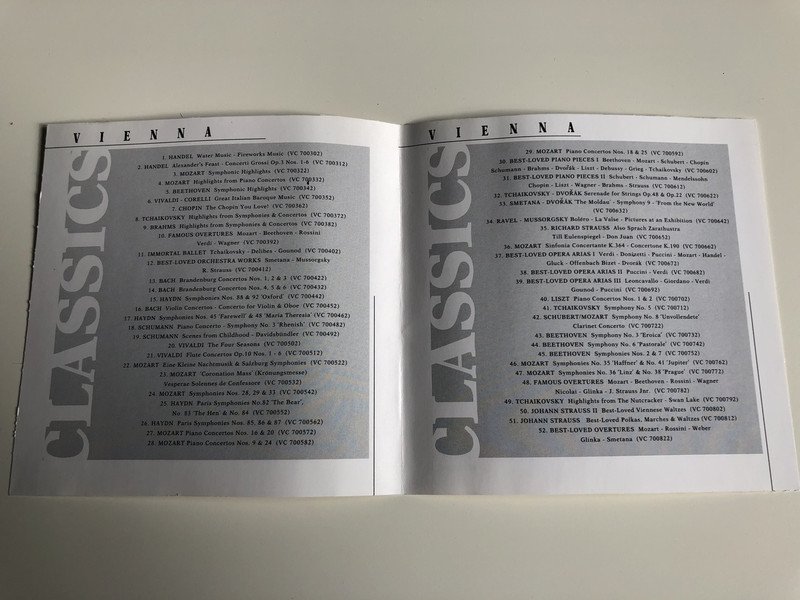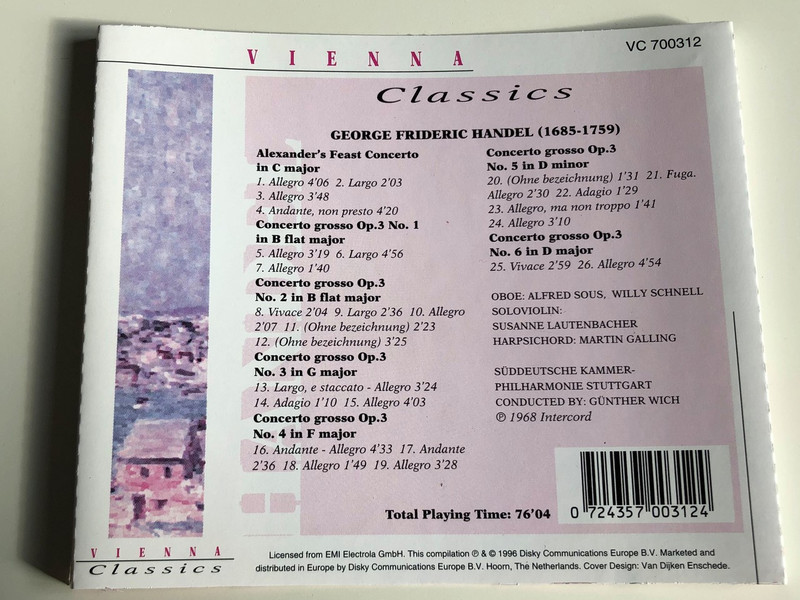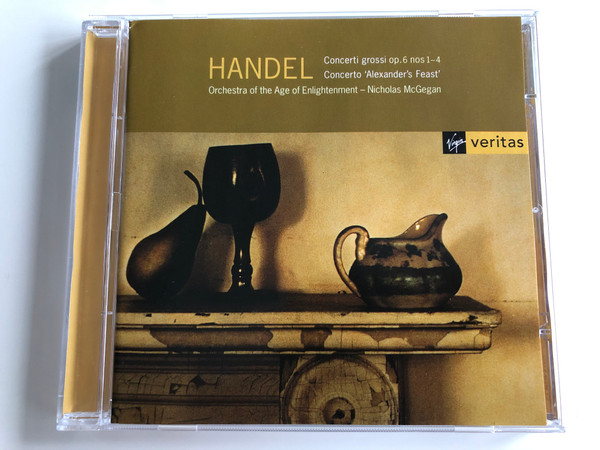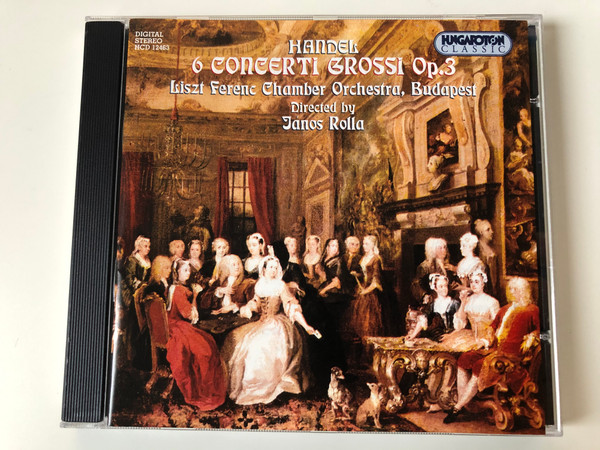Description
Vienna Classics Handel - Alexander's Feast Concerti Grossi Op. 3 Nos. 1-6
UPC 0724357003124
OBOE: ALFRED SOUS, WILLY SCHENELL
SOLOVIOLIN: SUSANNE LAUTENBACHER
HARPSICHORD: MARTIN GALLING
The structure of Op. 3 is somewhat unusual. The six concertos have anything between two and five movements, but only one of them contains the usual four movements. Only occasionally are the instrumental forces set in the traditional concerto grosso manner, i.e. a tutti group and a contrasting, soloistic concertino group. However, the concertos are filled with virtuoso solo passages for both the strings and the woodwinds, thus maintaining the form of the concerto grosso despite the lack of traditional contrasting forces.
Concerto Grosso in B flat major, Op. 3, No. 1 - HWV 312
The first and probably earliest concerto of the set is scored for two recorders, two oboes, two bassoons, strings (with divided viola), and continuo. It is unusual in that only its first movement is in the tonic key of B-flat—the other two are in the relative minor, G minor.
- I. Allegro
- II. Largo
- III. Allegro
Concerto Grosso in B flat major, Op. 3, No. 2 - HWV 313
The second concerto contains four movements in B flat major and one (the second) in G minor. The opening movement of the five-movement concerto bears a close relationship to Handel's Brockes Passion of 1716. Unusually, two dance movements, a minuet, and a gavotte complete the concerto. The final gavotte bears a close resemblance to "The King Shall Rejoice" from Handel's Coronation Anthems. The concerto is scored for two oboes, one bassoon, strings, and continuo.
- I. Vivace
- II. Largo
- III. Allegro
- IV. Moderato
- V. Allegro
Concerto Grosso in G major, Op. 3, No. 3 - HWV 314
The third Concerto is again in three movements (the opening Largo is too brief to be classified as a movement). There is little doubt that this concerto was compiled by Walsh from a number of pieces by Handel. The concerto is scored for one oboe (can also be replaced by flute), one bassoon, strings, and continuo.
- I. Largo, e staccato — allegro
- II. Andante
- III. Allegro
Concerto Grosso in F major, Op. 3, No. 4 - HWV 315
The fourth concerto is the only piece in the opus that follow a four movement framework. Although the layout of this work does not reflect the typical concerto grosso as the music was pulled straight from the 1716 overture to the 1715 opera Amadigi di Gaula, the piece uniquely displays many aspects of Handel's concerto grosso style. The piece is scored for two oboes, one bassoon, strings, and continuo.
- I. Largo
- II. Andante
- III. Allegro
- IV. Allegro
Walsh also published a 'No. 4b' concerto erroneously under the name of Handel but it was withdrawn a few months later, possibly at Handel's request.
Concerto Grosso in D minor, Op. 3, No. 5 - HWV 316
Despite lack of division into tutti and concertino and the addition of an extra allegro movement at the very end, the fifth concerto follows the traditional Italian model most closely of all the Op. 3 works. Walsh at first only published the first two movements, but because the work had already been known in its entirety, it is probable that Handel requested it be published in full. The piece is scored for two oboes (originally one), one bassoon, strings, and continuo.
- I. Largo
- II. Fuga, allegro
- III. Adagio
- IV. Allegro, ma non troppo
- V. Allegro
Concerto Grosso in D major, Op. 3 No. 6 - HWV 317
The sixth and final concerto has just two movements, the Vivace, whose music is extracted from the 1723 opera Ottone, and the Allegro, which is also Handel's first published piece for organ and orchestra, and is taken from the overture to the 1712 opera Il pastor fido. The piece is scored for two oboes, one bassoon, strings, and continuo. The Allegro of the concerto was publisher Walsh's 'commercial' announcement of the forthcoming edition of Handel's opus 4: a set of organ- (or cembalo-)concertos.
- I. Vivace
- II. Allegro
TOTAL TIME: 76:04
The Concerti Grossi, Op. 3, HWV 312–317, are six concerti grossi by George Frideric Handel compiled into a set and published by John Walsh in 1734. Musicologists now agree that Handel had no initial knowledge of the publishing. Instead, Walsh, seeking to take advantage of the commercial success of Corelli's Opus 6 Concerti Grossi, simply combined several of Handel's already existing works and grouped them into six "concertos" .
George Frideric (or Frederick) Handel born Georg Friedrich Händel 23 February 1685 (O.S.)[(N.S.) 5 March] – 14 April 1759) was a German, later British, Baroque composer who spent the bulk of his career in London, becoming well-known for his operas, oratorios, anthems, and organ concertos. Handel received important training in Halle-upon-Saale and worked as a composer in Hamburg and Italy before settling in London in 1712; he became a naturalised British subject in 1727. He was strongly influenced both by the great composers of the Italian Baroque and by the middle-German polyphonic choral tradition.
Within fifteen years, Handel had started three commercial opera companies to supply the English nobility with Italian opera. Musicologist Winton Deanwrites that his operas show that "Handel was not only a great composer; he was a dramatic genius of the first order." As Alexander's Feast (1736) was well received, Handel made a transition to English choral works. After his success with Messiah (1742) he never composed an Italian opera again. Almost blind, and having lived in England for nearly fifty years, he died in 1759, a respected and rich man. His funeral was given full state honours, and he was buried in Westminster Abbey in London.
Born the same year as Johann Sebastian Bach and Domenico Scarlatti, Handel is regarded as one of the greatest composers of the Baroque era, with works such as Messiah, Water Music, and Music for the Royal Fireworks remaining steadfastly popular. One of his four coronation anthems, Zadok the Priest (1727), composed for the coronation of George II, has been performed at every subsequent British coronation, traditionally during the sovereign's anointing. Another of his English oratorios, Solomon (1748), has also remained popular, with the Sinfonia that opens act 3 (known more commonly as "The Arrival of the Queen of Sheba") featuring at the 2012 London Olympics opening ceremony. Handel composed more than forty operas in over thirty years, and since the late 1960s, with the revival of baroque music and historically informed musical performance, interest in Handel's operas has grown.

